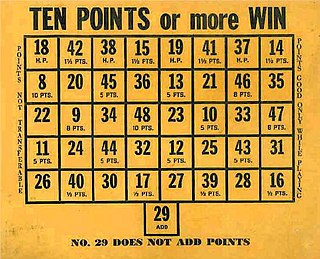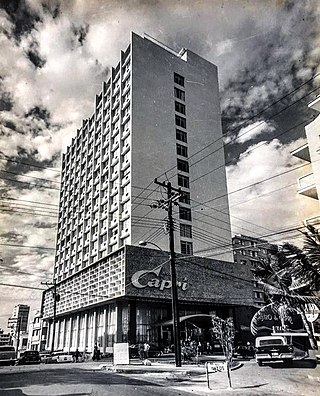
Fulgencio Batista y Zaldívar was a Cuban military officer and politician who served as the elected president of Cuba from 1940 to 1944 and as a military dictator from 1952 until his overthrow in the Cuban Revolution in 1958.

Santo Trafficante Jr. was among the most powerful Mafia bosses in the United States. He headed the Trafficante crime family from 1954 to 1987 and controlled organized criminal operations in Florida and Cuba, which had previously been consolidated from several rival gangs by his father, Santo Trafficante Sr.
The Havana Conference of 1946 was a historic meeting of United States Mafia and Cosa Nostra leaders in Havana, Cuba. Supposedly arranged by Charles "Lucky" Luciano, the conference was held to discuss important mob policies, rules, and business interests. The Havana Conference was attended by delegations representing crime families throughout the United States. The conference was held during the week of December 22, 1946, at the Hotel Nacional. The Havana Conference is considered to have been the most important mob summit since the Atlantic City Conference of 1929. Decisions made in Havana resonated throughout US crime families during the ensuing decades.
Sans souci is French for "no worries" or "carefree".

Tropicana Atlantic City, often referred to as The Trop, is a resort, casino hotel located on the beach and Boardwalk in Atlantic City, New Jersey. It is owned by Gaming and Leisure Properties and operated by Caesars Entertainment, and is the third largest hotel in New Jersey, with just under 2,400 guest rooms and the 200,000-square-foot shopping and entertainment complex, The Quarter. It has over 30 restaurants, 30 shops, 20 bars and lounges, 4 pools, the Tropicana Showroom, multiple spas, and an IMAX Theatre. In 2016, Tropicana completed over $200 million in renovations and additions, including a Multimedia Light and Sound Show, the addition of AtlantiCare LifeCenter Fitness, Garces restaurants, renovations to over 900 hotel rooms, and casino floor but Tropicana will continue investing. The Tropicana is the largest resort and casino on the boardwalk, with 2,364 rooms, 3,000 slot machines, 30 restaurants, and 30 shops, along with two 2,500-space parking garages, totaling over 5,000 parking spaces. In 2021-2023 Tropicana is said to complete renovations through these years, the renovations will include renovations to all 604 West Tower rooms, modernized elevators and escalators, pool enhancements, gaming space enhancements, and more undisclosed renovation projects.

El Tropicana Night Club in Havana, Cuba located in a lush, 36,000-square-metre (390,000 sq ft) estate tropical garden opened on December 30, 1939 at the Villa Mina in Marianao. It is located next door to the old Colegio de Belén, Havana, presently, the Instituto Técnico Militar.

Razzle is a scam sometimes presented as a gambling game on carnival midways and historically, in the casinos of Havana, Cuba. The player throws a number of marbles onto a grid of holes, and the numbers of those holes award points which it is suggested can be converted into prizes. In reality, it is almost impossible for a player to win enough points for the prize. According to gaming expert Darwin Ortiz, the Razzle is seldom, if ever, run honestly.
The Castaways was a hotel and casino on the Las Vegas Strip in Paradise, Nevada. It began in the 1930s, as a small motel called Mountain View. It became the San Souci in 1939, and underwent several ownership changes in its early years. A hotel addition opened on August 21, 1955, when the property became the Sans Souci Hotel. A casino, showroom, and restaurant were eventually opened on October 23, 1957. These facilities closed less than a year later, due to financial problems, although the hotel continued operations. Following a bankruptcy reorganization, the shuttered facilities reopened in May 1960. However, the property soon closed due to further financial difficulties.

Hotel Tryp Habana Libre is one of the larger hotels in Cuba, situated in Vedado, Havana. The hotel has 572 rooms in a 25-floor tower at Calle 23 and Calle L. Opened in 1958 as the Habana Hilton, the hotel famously served as the residence of Fidel Castro and other revolutionaries throughout 1959, after their capture of Havana.

The Hotel Nacional de Cuba is a historic Spanish eclectic style hotel in Havana, Cuba, opened in 1930. Located on the sea front of Vedado district, it stands on Taganana Hill, offering commanding views of the sea and the city.

John Sebastian LaRocca was the Sicilian-born American boss of the Pittsburgh crime family from the 1950s until his death in 1984.
Dino Cellini, ran casinos for New York mobster Meyer Lansky in Havana, Cuba during the late 1950s and early 1960s. Cellini later ran casinos in the Bahamas and the United Kingdom.

The Hotel Habana Riviera by Iberostar, originally known as the Havana Riviera, is a historic resort hotel located on the Malecón waterfront boulevard in the Vedado district of Havana, Cuba. The hotel,which is managed by the Spanish Iberostar chain, was built in 1957 and still maintains its original 1950s style. It has twenty-one floors containing 352 rooms all of which feature views of the water and the Vedado neighborhood.

Rita Aurelia Fulcida Montaner y Facenda, known as Rita Montaner, was a Cuban singer, pianist and actress. In Cuban parlance, she was a vedette, and was well known in Mexico City, Paris, Miami and New York, where she performed, filmed and recorded on numerous occasions. She was one of Cuba's most popular artists between the late 1920s and 1950s, renowned as Rita de Cuba. Though classically trained as a soprano for zarzuelas, her mark was made as a singer of Afro-Cuban salon songs including "The Peanut Vendor" and "Siboney".
Chicho Ibáñez, born José Ibáñez Noriega was the longest-lived and one of the most important members of the Cuban trova. He was significant because, unlike most of the others, he specialized in Afro-Cuban genres. He was a disciple of the tresero Eduardo Fusté, and a member of early groups in Cárdenas, such as Peonia and that of Benito Tumborombo. Later he moved to Havana, where he joined Los Veintiuno, directed by Alejandro Sotolongo, which used claves, maracas, marimbula, bongó and pianito. He worked in other groups, and in the Sans-Souci, formerly the leading cabaret in Havana.

The Hotel NH Capri La Habana is a historic high rise hotel located in central Havana, Cuba.
Norman Rothman was an American gangster.

Havana was founded in the sixteenth century displacing Santiago de Cuba as the island's most important city when it became a major port for Atlantic shipping, particularly the Spanish treasure fleet.

The Hotel Deauville is a historic hotel in Centro Habana located at Calle Galiano 1 on a corner with the Malecón promenade, and overlooking the Bay of Havana. The hotel was constructed as a casino hotel in 1957 by a consortium owned by American mobster Santo Trafficante Jr.

The Havana Plan Piloto was a 1955–1958 urban proposal by Town Planning Associates, which included Paul Lester Wiener, Paul Schulz, the Catalan architect Josep Lluis Sert, and Seely Stevenson of Value & Knecht, Consulting Engineers, seeking to combine "architecture, planning, and law". The Charter got its name from the location of the fourth CIAM conference in 1933, which, due to the deteriorating political situation in Russia, took place on the "in SS Patris II" bound for Athens from Marseilles. This conference is documented in a film commissioned by Sigfried Giedion and made by his friend László Moholy-Nagy. The Charter had a significant impact on urban planning after World War II and, through Josep Lluis Sert and Paul Lester Wiener, on the proposed modernization of Havana and in an effort to erase all vestiges of the 16th-century city. The plan was abandoned and was not made.

















